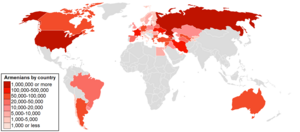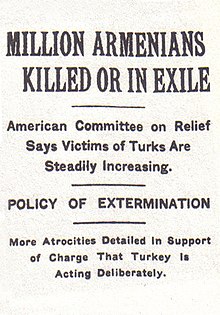Armenian diaspora
The Armenian diaspora is a term used to describe the communities that have been founded by Armenians living outside of Armenia and Upper Karabakh. Of the total Armenian population living in the world (in 2004 it was estimated at just over 12,000,000 people), only about 3,300,000 live in Armenia and about 140,000 in the Upper Karabakh region. The Armenian diaspora is estimated to have a population of approximately 8,000,000 people. Only one fifth of the world's Armenian population lives in the former Soviet Republic of Armenia, including the pre-World War I and 1920 Armenian territories., which covered a territory five or six times the size of present-day Armenia, including the eastern regions of Turkey, parts of Iran and parts of Syria.
Origin
Although an Armenian diaspora has existed since the loss of statehood in 1375, when the Armenian Kingdom of Cilicia fell under the control of the Mamluks, the exile population grew exponentially after the Armenian genocide. Although many Armenians died, others managed to escape and settled in various countries in Eastern Europe, the Balkans, the Middle East and cities such as Moscow and Sochi in Russia, Odessa, Sevastopol and Crimea in the Ukraine, Tbilisi and Batumi in Georgia, Plovdiv in Bulgaria, Athens in Greece, Beirut in Lebanon and Aleppo in Syria. Israel is home to a small and very old Armenian community centered on the so-called Armenian Quarter of Jerusalem.
Several million Armenians settled in Western Europe (i.e., France, Germany, Italy, and the Netherlands) and in America (North and South), beginning in the 1890s. Some significant Armenian communities exist as well. in the Far East of Russia, as well as in the former Soviet republics of Central Asia. Some of these groups were encouraged to settle in the area by the Tsarist and Soviet authorities, while others have no choice, being part of the population deported by Stalin. Small Armenian communities can be found in India, Australia, New Zealand, Sub-Saharan Africa (Sudan, South Africa, and Ethiopia), and in the Far East: Singapore, Burma, and Hong Kong. Armenian exile communities existed in China, Japan, and the Philippines, but Armenian culture in these countries has virtually disappeared.
After the genocide
Immediately after the Armenian genocide, large numbers of Diaspora Armenians lived in refugee camps. However, with the improvement of the financial situation, the camps were converted into cities. This was the case in many of the Armenian-populated regions in Lebanon, such as Anjar and Bourj Hammoud. Over time, Armenians organized themselves by building churches, schools, community centers, etc. Various political parties and charitable unions, such as the Armenian Revolutionary Federation (FRA or Dashnaktsutiun), the Henchakian Social-Democratic Party and the Armenian General Benevolent Union (AGBU), established themselves where there were a number of considerable amount of Armenians.
Between the 1940s and 1950s, the Soviet Union tried to extend its influence throughout the world, and especially in the Middle East. The Henchakian Social Democratic Party, ideologically close to communism, supported the Soviet Union in its effort to expand its sphere of influence in the Middle East. The ASEAN Regional Forum, despite its socialist background, was a nationalist party, and it was opposed, as it stood for the idea of a free, independent, united and Armenian country. The FRA fought to preserve the flag, coat of arms and national anthem of the Independent Republic of Armenia from 1918-1922, while other groups opted for Soviet support, seeing it as the only place in the world where Armenians could live with security.
There is also a conflict at the level of the Armenian Apostolic Church, which has two Catholicos. The Catholicos of all Armenians has its headquarters in Echmiadzin, Armenia, while the Catholicos of the Great House of Cilicia resides in Antelias, Lebanon. During the "cold war" era, the Echmiadzin Catholicosate was under Soviet control and had the support of the Henchakian and Ramgavar parties, while from 1956 the F.R.A. he sided with the Catholicosate of Cilicia, as he thought that the Catholicosate of Echmiadzin was a tool for the propagation of communism. In 1958, during the height of this conflict, there were armed clashes between supporters of both sides, including assassinations and desertions, in Lebanon. However, the tensions ended in 1975, during the Lebanese civil war, when the Armenians had to unite in order to survive between both fires. Armenian citizens of Iraq and Iran fought in both armies during the Iran-Iraq war between 1980 and 1988.
Second Diaspora
After the pan-Arab expansion in Egypt and Syria, Islamism in Iran, and civil war in Lebanon, tens of thousands of Armenians emigrated from the Middle East, settling in the United States, Canada, France, and elsewhere, where they founded pressure groups to support the Republic of Armenia and spread international recognition and condemnation of the Armenian genocide. Today, the countries with the largest number of Armenians (excluding Armenia and Nagorno-Karabakh) are Russia, the United States, France, Iran (although its community has been greatly reduced since the 1970s), Lebanon, Georgia, Syria, Argentina, Canada and Ukraine.
Armenian population in the world
|}
Contenido relacionado
Pigeons
Vernacular
Jose Guadalupe Posada



